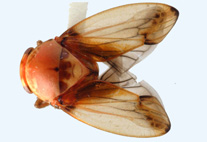Abstract
Dario huli, new species, is described from a small tributary stream of the Tunga River in southern Karnataka, India. It can be distinguished from all its congeners except D. urops by the presence of a conspicuous black caudal-fin blotch and by anterior dorsal-fin lappets in males not being produced beyond fin spines. It is readily distinguished from Dario urops by the absence of the horizontal suborbital stripe (vs. presence), the presence of a series of up to eight black bars on the body (vs. 2–3 black bars restricted to caudal peduncle), 25 scales in a lateral row (vs. 28), 3–5 tubed lateral-line scales (vs. tubed lateral-line scales completely absent), 13+13=26 vertebrae (vs. 14+14–15=28-29), and the presence of teeth on hypobranchial 3 (vs. absence of teeth).

